How To Make Homemade Bagels
Warm, chewy bagels are one of life’s pure pleasures. But what most people don’t know is that they’re also one of the simplest breads to make at home. We’re here to walk you through the process, step by step. So get your knead on, then boil and bake!
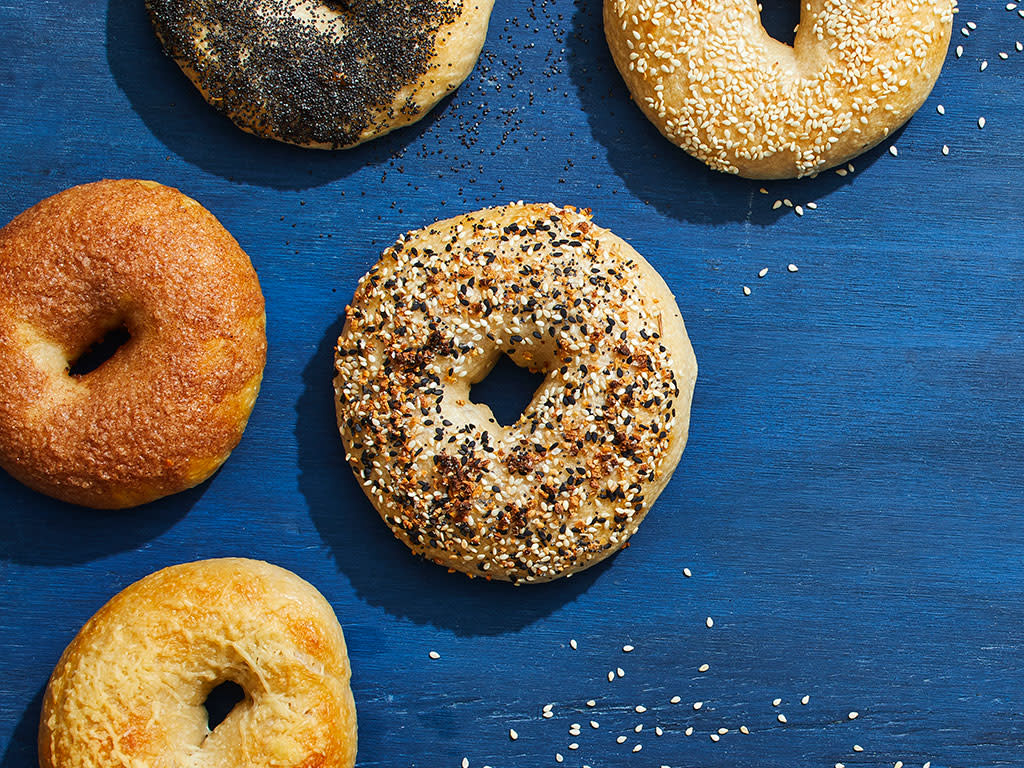
True New York bagels are a thing of beauty. Boiled then baked, they’re dense but not too dense, with glossy, crackly crusts and soft insides. But NYC isn’t the only place to get decent bagels — they’re one of the simplest breads to make at home.
The secrets, if you will, start with a long (overnight) cold proof to help build flavor. Plus, using bread flour, which is higher in protein than all-purpose flour, helps achieve that chewy texture. And, using a lower percentage of water than what’s typically used in other bread doughs produces a stiff dough that can stand up to boiling the bagels, helping to set the crust before baking.
One word about the stiffness of the dough: It will “thump” the sides of the bowl of your stand mixer. But, if your mixer appears to struggle, finish kneading the dough by hand until smooth and elastic.
When it comes to shaping, there are two methods. Shape the dough into balls and then poke a hole in each center, stretching until the right size. Or, divide the dough into portions, roll each portion into ropes, then squeeze the ends together. We prefer the former method, while professionals prefer the latter — try both to see which one you prefer.
You can hear Pam and Robin discuss the method in depth in Episode 57 of our Must Love Food podcast. Then just grab our Homemade Bagels recipe and follow along with the steps below — and don't forget to pick up some cream cheese.
How to Make Bagels, Step by Step
Step 1: Make the Dough & Let Rise
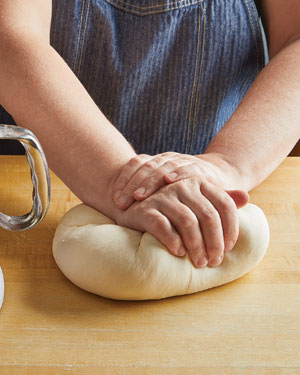 Because bagels rely on bread flour, which has a higher protein content, the dough tends to be very stiff (yet supple, with a satiny but not tacky feel) and takes a bit more time and effort to develop the gluten.
Because bagels rely on bread flour, which has a higher protein content, the dough tends to be very stiff (yet supple, with a satiny but not tacky feel) and takes a bit more time and effort to develop the gluten.
Whisk together flour, salt, and yeast in the bowl of a stand mixer (See our Homemade Bagels recipe for measurements).
Combine 2¼ cups water and honey, then add to flour mixture.
Mix dough on low speed with a dough hook until ingredients come together, then increase speed to medium-low and knead dough until smooth and elastic. (Bagel dough should be quite stiff and not at all tacky. If the mixer struggles to knead the dough, remove it from the mixer and finish kneading by hand.)
Coat the inside of a bowl with nonstick spray. Place dough in bowl, turn to coat, then cover with plastic wrap and let rise until doubled in size, about 2 hours.
Step 2: Punch Down & Divide the Dough
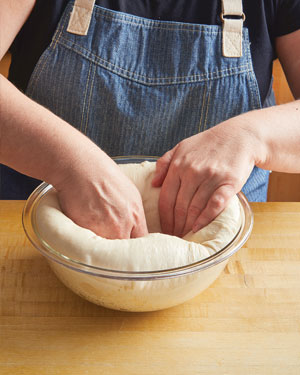 Since bagels are meant to be chewy and denser than other breads, punching down the dough helps to deflate it and remove air bubbles so you can easily divide and form the dough into bagel shapes, using your preferred method.
Since bagels are meant to be chewy and denser than other breads, punching down the dough helps to deflate it and remove air bubbles so you can easily divide and form the dough into bagel shapes, using your preferred method.
Punch down dough; divide into 12 (about 4 oz.) pieces. Loosely cover dough with plastic wrap while weighing and shaping bagels.
Step 3: Shape the Dough — 2 Methods
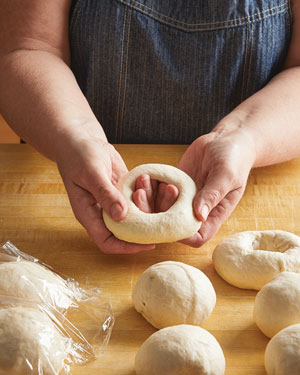 Shaping Method 1: Roll each piece of dough into a smooth round ball, making sure the seam on the bottom disappears. Poke a hole in the middle and stretch it into a ring (until the hole is about 2 inches in diameter). Adjust the shape as needed.
Shaping Method 1: Roll each piece of dough into a smooth round ball, making sure the seam on the bottom disappears. Poke a hole in the middle and stretch it into a ring (until the hole is about 2 inches in diameter). Adjust the shape as needed.
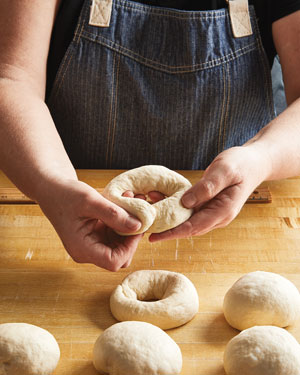 Shaping Method 2: Flatten each
piece of dough; roll each into an
11-inch-long rope. Grasp one end of
the rope in your palm, wrap the rope
around the back of your hand, then
overlap the ends of the rope by
1 inch. Squeeze the ends together,
then gently roll squeezed ends to
create a bagel with even thickness.
Shaping Method 2: Flatten each
piece of dough; roll each into an
11-inch-long rope. Grasp one end of
the rope in your palm, wrap the rope
around the back of your hand, then
overlap the ends of the rope by
1 inch. Squeeze the ends together,
then gently roll squeezed ends to
create a bagel with even thickness.
Set on prepared baking sheet.
Step 4: Rest Bagels Overnight
Cover baking sheets of shaped bagels loosely with plastic wrap and refrigerate overnight.
Step 5: Test For Readiness
Remove bagels from refrigerator; add one to a bowl of cold water. (If it floats, they’re ready to boil. If it sinks, let bagels continue to rise at room temperature, 15–20 minutes, then test again. Repeat procedure until it floats.)
Meanwhile, preheat oven to 500°.
Step 6: Boil the Bagels
Bagels are boiled to help set the crust before baking (it
also reactivates the yeast). Turn the bagels once so both
sides “sit” in the boiling water. And note, the longer the
boil, the thicker and chewier the crust will be.
 Traditionally, bagels are boiled with lye or barley malt
extract to help the crusts brown, give them distinct flavor,
and affect the water’s alkalinity. These days, baking soda
is often substituted for lye.
Traditionally, bagels are boiled with lye or barley malt
extract to help the crusts brown, give them distinct flavor,
and affect the water’s alkalinity. These days, baking soda
is often substituted for lye.
Heat 4 qt. water and baking soda in a pot to a boil over medium-high.
Boil bagels, a few at a time, 45–60
seconds per side, then transfer to
baking sheets lined with parchment.
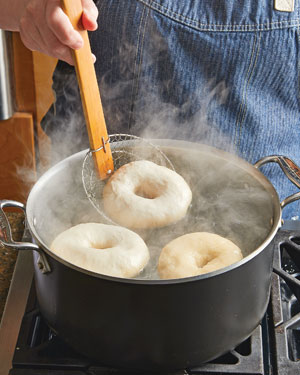
Step 7: Top Bagels
Place each topping in a separate Bowl.
Dip rounded side of bagels in toppings and place back on baking sheets.
For Asiago cheese, to make sure the cheese adheres, sprinkle the Asiago over each bagel. (You’ll also want to broil Asiago-topped bagels after baking them, to help the cheese brown.)
For cinnamon-sugar butter, grab clumps of the “paste,” press and flatten the clumps, then arrange several on top of boiled bagels to cover before baking them.
Step 8: Bake the Bagels
Bake bagels until golden and they sound hollow when tapped on the bottoms, about 11 minutes. (For Asiago, after baking, broil bagels on high until golden, 1–2 minutes.)
Enjoy!
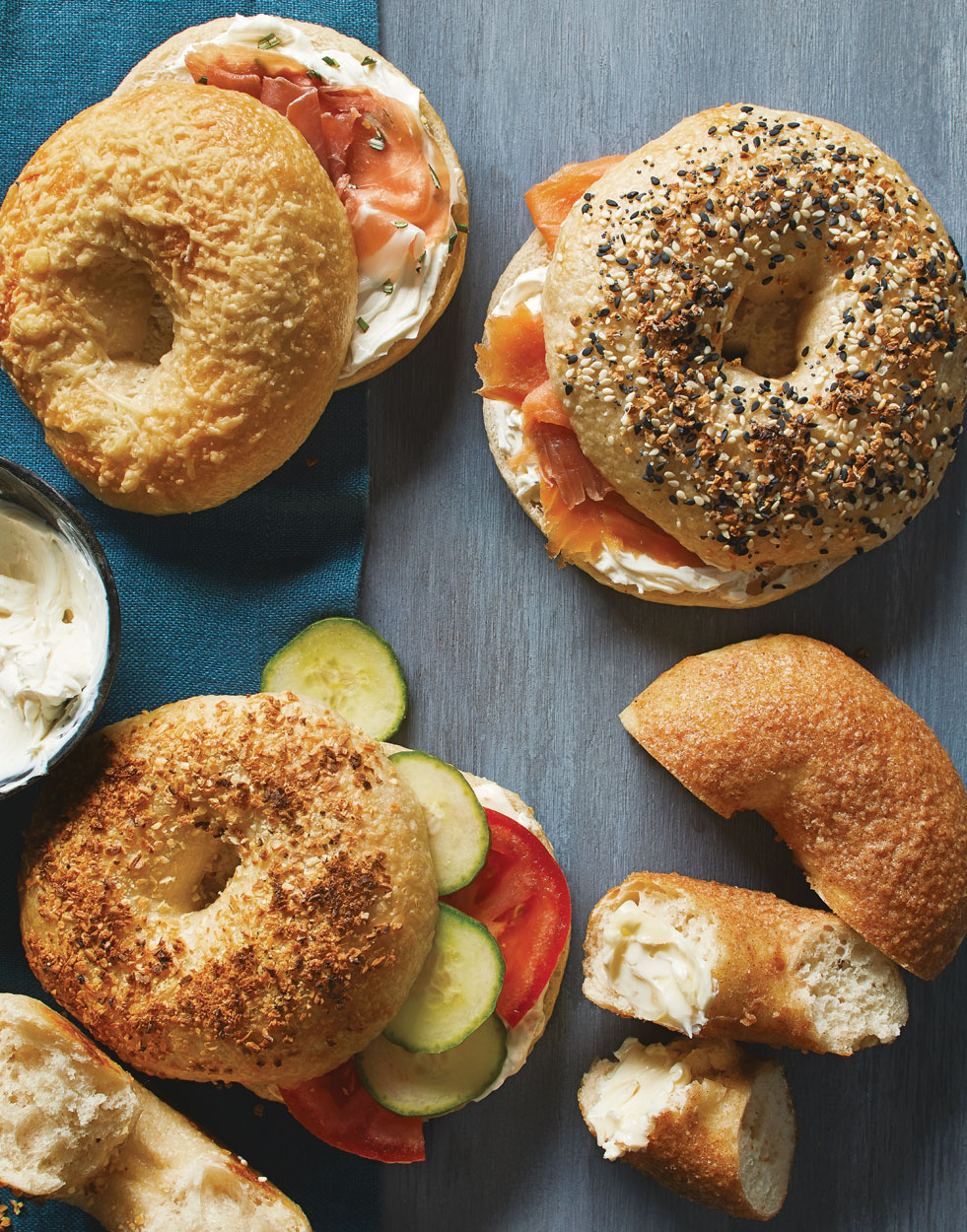
Product Recommendations
Interested in cooking? Need some supplies?
Check out some of the tools we like. All products featured on Cuisine at Home are independently selected by our editors; we may earn an affiliate commission from qualifying purchases through our links.